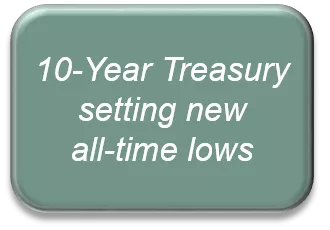March Economic Commentary: Marching into unknown territory

Chief Economist
Pohlad Companies
The acceleration of overall anxiety in the past two weeks related to the coronavirus has made most recent economic reports irrelevant. The financial shock that markets are experiencing is likely to weigh heavily on economic growth prospects for at least the next few quarters. Earlier concerns about the halting of production of the Max 737 at Boeing and tariffs with China have faded from the headlines although those realities still exist.
Fed Rate Cuts
In the first two business days of March, the Fed made an emergency in-between-meetings cut of 50 basis points in the Fed Funds for the first time since the financial crisis. This brings the target range for Fed Funds to 1.00% to 1.25%. Credit markets expect another 75 basis points of cuts over the next 90 days. The health emergency is spawning a liquidity crisis that the Fed is responding to. Expect further action from the Fed.

Additionally, the yield on 10-year Treasuries ended Friday, March 6, at 0.71%. For context, the 10-year Treasury started the year at 1.92% and is now 121 basis points lower at all-time lows. The 2-year and 30-year Treasuries have made similar moves from their levels recorded at the beginning of the year.
The greatest determinant of long-term interest rates is inflationary expectations. With economic growth expected to slow, and Russia, Saudi Arabia, and the U.S. fighting over the price of oil, don’t expect inflationary pressures to develop anytime soon. Consequently, long-term interest rates are likely to remain under downward pressure.
Employment
The employment report released on Friday indicated that the labor market was on solid footing before the spread of the coronavirus intensified. Data in the monthly report reflects the employment situation for the pay period that includes the 12th of the month. Markets did not begin to fall in earnest until February 24.
The February report showed that U.S. payrolls recorded their largest gain since May 2018 as they rose by 273,000. The unemployment rate fell back to 3.5% (a 50-year low) and average hourly earnings grew 3.0% on a year-over-year basis. While this report was very strong, it is now considered outdated.
Equity Markets
Equity markets reflect the fear and uncertainty associated with the spread of the virus. As of Friday, the S&P 500 is down 8% for the year to date. It has fallen 12% from its all-time high recorded on February 19. The sell-off has been broad-based with all sectors declining since February 24—the start of the sharp market decline. Impaired supply chains and lost business are resulting in many businesses not providing guidance about future earnings. Investors are assuming the worst and are reacting by selling stocks.
As discussed in prior reports, the U.S. economy was already slowing throughout 2019. The economy is now being hit from both the supply side and the demand side, pushing it toward a stall speed. On the supply side, companies dependent on product from China are scrambling for alternatives. On the demand side, savings rates have been rising and spending is being curtailed.
What to Watch
If economic growth prospects remain impaired, corporate profits will suffer and will likely result in layoffs. Some industries such as hospitality and transportation are already experiencing this. It will be most important, then, to watch the behavior of the consumer as the consumer has been the primary support for economic growth the past few years. As the consumer goes, so goes the U.S. economy.
Insights
Research to help you make knowledgeable investment decisions